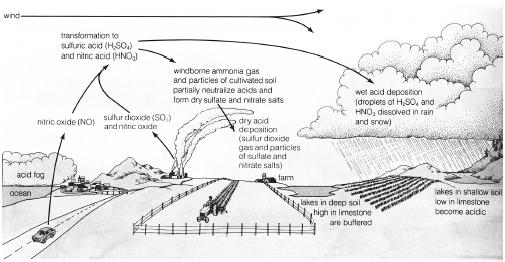 The basic mechanisms of acid deposition. (Illustration by Wadsworth Inc. Reproduced by permission.)
The basic mechanisms of acid deposition. (Illustration by Wadsworth Inc. Reproduced by permission.)
The following sections of this BookRags Literature Study Guide is offprint from Gale's For Students Series: Presenting Analysis, Context, and Criticism on Commonly Studied Works: Introduction, Author Biography, Plot Summary, Characters, Themes, Style, Historical Context, Critical Overview, Criticism and Critical Essays, Media Adaptations, Topics for Further Study, Compare & Contrast, What Do I Read Next?, For Further Study, and Sources.
(c)1998-2002; (c)2002 by Gale. Gale is an imprint of The Gale Group, Inc., a division of Thomson Learning, Inc. Gale and Design and Thomson Learning are trademarks used herein under license.
The following sections, if they exist, are offprint from Beacham's Encyclopedia of Popular Fiction: "Social Concerns", "Thematic Overview", "Techniques", "Literary Precedents", "Key Questions", "Related Titles", "Adaptations", "Related Web Sites". (c)1994-2005, by Walton Beacham.
The following sections, if they exist, are offprint from Beacham's Guide to Literature for Young Adults: "About the Author", "Overview", "Setting", "Literary Qualities", "Social Sensitivity", "Topics for Discussion", "Ideas for Reports and Papers". (c)1994-2005, by Walton Beacham.
All other sections in this Literature Study Guide are owned and copyrighted by BookRags, Inc.
 The basic mechanisms of acid deposition. (Illustration by Wadsworth Inc. Reproduced by permission.)
The basic mechanisms of acid deposition. (Illustration by Wadsworth Inc. Reproduced by permission.)
Acid precipitation from the atmosphere, whether in the form of dryfall (finely divided acidic salts), rain, or snow. Naturally occurring carbonic acid normally makes rain and snow mildly acidic (approximately 5.6 pH). Human activities often introduce much stronger and more damaging acids. Sulfuric acids formed from sulfur oxides released in coal or oil combustion or smelting of sulfide ores predominate as the major atmospheric acid in industrialized areas. Nitric acid created from nitrogen oxides, formed by oxidizing atmospheric nitrogen when any fuel is burned in an oxygen-rich environment, constitutes the major source of acid precipitation in such cities as Los Angeles with little industry, but large numbers of trucks and automobiles. The damage caused to building materials, human health, crops, and natural ecosystems by atmospheric acids amounts to billions of dollars per year in the United States.